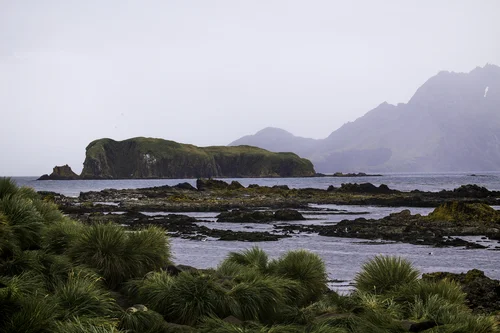We have just spent 2 days at sea navigating from the Falkland Islands to South Georgia Island in the Southern Atlantic Ocean. I'm starting to think that maybe I should accept the dry mouth you get from a scopolamine patch in return for less nausea. It is OK though. I've survived, and now it is time to take in one of the highlights of all my world travels, South Georgia Island.
Never having experienced this type of travel before, I'm getting used to the format. There are clear cut destinations that are made well beforehand by our Polar Latitude's group leader, in consultation with the Sea Explorer's captain. Prion Islet, as well as many other sites on South Georgia Island, is designated as a Specially Protected Area by the South Georgia Government. The ship is given a visit application and permit. Strict rules for landing on all sites are enforced, including having our boots cleaned with a sterilizing solution before we make landfall.
On this day, having handled the turbulent waters of the Scotia Sea, located at the northern edge of the Southern Ocean, the ship's plan to anchor off the coast of the Salisbury Plain has been thwarted by the weather conditions. Flexibility is the rule under these circumstances. A decision is made to maneuver towards Prion Islet, hoping that the weather situation will improve.
It is now afternoon, and we're in luck! The winds have diminished and we can make landfall. The zodiacs are lowered, and we head to shore. This is clearly a paradise for wildlife lovers, with a multitude of animals conducting their lives with little concern for us picture-taking humans.
The ecology of this area bears explanation. Rats have become a major problem for oceanic islands worldwide. Their origin is from sealing vessels that reached South Georgia in the late 18th and 19th centuries. These rodents wreaked havoc with ground nesting and burrowing birds, the result of which has been the destruction of their habitats on the main island of South Georgia. Fortunately, the rats have never colonized the smaller offshore islands, such as Prion Islet, allowing the preservation of animal life here to flourish.
As I scope out this area, immediately obvious are the nesting sites of magnificent wandering albatrosses. These are large seabirds that are found in a circumpolar range in the Southern Ocean. One of the largest birds in the world, they have a wingspan that ranges between 8 ft. 3 in. to 11 ft. 6 in. Spending most of their lives in flight, these creatures land only to breed and feed.
In order to see the wildlife, we have to stay on a boardwalk as we hike around this habitat. This serves the purpose of making access easier while protecting the fragile vegetation on the island. While ascending this walkway, I occasionally have to give the right of way to any fur seals that may be headed in the same direction.
Approximately 95% of the world's population of Antarctic fur seals breed on South Georgia Island. These animals possess a short and broad snout. The males are dark brown in color, while the females and juveniles have lighter grey undersides. The males are polygynous, breeding with up to a dozen female partners in a single season. They stake out their breeding territories aggressively in defense of their harems.
Cruising along the board walk, I make sightings of several Antarctic Prions, Brown Skuas and Northern Giant Petrels. I'm told that on fortuitous occasions, South Georgia Pintails and Pipits also make appearances.
Following the rules, our group leader begins the process of getting us loaded onto our zodiac for transport back to the Sea Explorer. Only 50 people are allowed on shore here at any one time, and the next group from our ship is patiently waiting their turn. I look forward to resting up for a short time before our excursion to Salisbury Plain.




